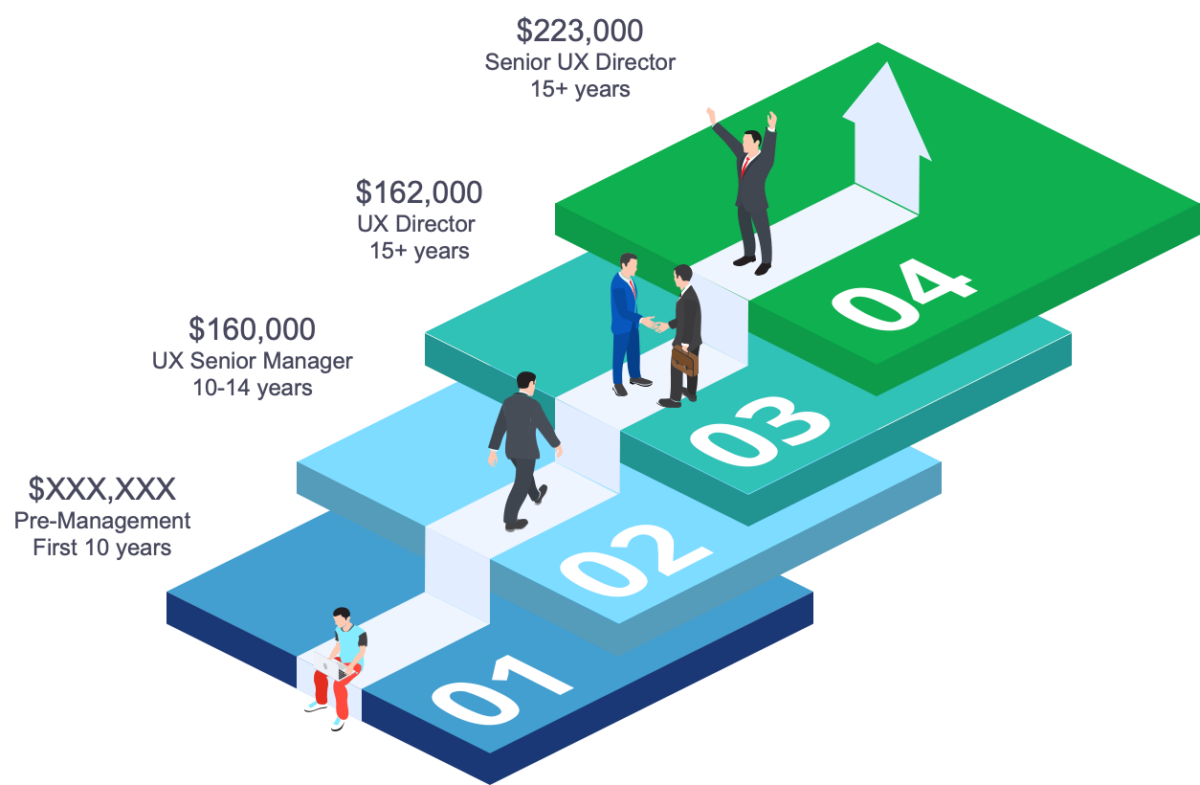Free UX Design Course
Dive into UX design with our free starter course. Transform your creative ideas into user-friendly solutions.
The life of a UX manager is much different than that of a non-manager (aka individual contributor). People skills are even more important. Advanced planning, resource allocation, delegation, risk mitigation, program oversight, recruiting and cultivating talent, and endless UX advocacy are the new norm. Strategic longer-term thinking takes up more of your brain too, whereas the focus before management trended toward excelling as a tactician.
Learn more about the roles, responsibilities, and salary of a UX manager.
Why is UX management important?
Any UX leadership position required executing smooth collaboration among user-centered design, research, product, engineering, marketing, and sales, among other business functions.
Proper care and maintenance of user experience professionals, projects, and programs is no easy task and has ripple effects that reach many aspects of an organization. UX leadership done poorly affects everything from financials, customer experience, and strategic organizational goals to personnel performance, company morale, and brand perception.
In reverse, UX leadership done well results in a number of improvements for every one of those ripple effects, resulting in better product, personnel, and company performance. Who wouldn’t want that?
Related: What is UX Design?
What does a UX manager do?
UX managers elevate the people on their team, starting with junior and mid-level members. The goal is to implement and execute a wholesome team strategy that identifies and responds to the UX needs of the larger business.
One of the primary differences between mid-level UX managers (e.g., senior managers) and higher-level ones (e.g., senior directors) is the scale of responsibility. These roles have the potential to manage hundreds of people indirectly, so key differences exist in that regard, but the following types of responsibilities apply broadly:
- Recruit, grow, and lead UX team(s)
- Acquire funding for hiring, research, and design efforts
- Establish and innovate user-centered design processes
- Liaise with middle and upper leadership by connecting UX to the wider business organization
- Advocate for the role of user experience, design, and research in making more data-driven decisions
- Regularly report out to various leaders and teams in the company about UX programs, projects, success stories, and best practices
- Own and manage key UX artifacts, such as user journeys, personas, longitudinal research, UX measurement, etc.
- Support the continual optimization of product development
Related: What Does a UX Designer Do?
What makes UX managers unique?
UX managers and directors should always have direct UX experience at the individual contributor level. Oftentimes, they have already spent up to ten years as a practitioner and truly understand both the research and design sides of the equation.
They know the challenges and rewards of including customer voices in product development processes, having earned their stripes the hard way. Furthermore, successful UX leaders can smoothly speak the language of other verticals in the company, such as marketing, sales, engineering, and even finance. This ability to effectively liaise with multiple layers of an organization makes them extremely valuable and that’s also why they are paid so well.
Get To Know Other Design Students
Sinem Ozkaya
UX Designer at Microsoft
Dominick Andre
UX Designer at Fidelity Investments
Erich Schulz
Product Designer at Disney Parks, Experiences And Products
What tech skills do UX managers need?
As with most disciplines, when compared to non-management jobs, managers deal more with people and less with technical details on a day-to-day basis. Therefore, the technical skills required of UX managers are not very extensive, although mastery of specialized UX tools only helps gain the respect of direct reports.
- Standard office software (word processing, spreadsheets, email, instant messaging, etc.)
- Web conferencing for meetings and moderated studies
- Design tools such as Invision, Sketch, Adobe XD, Marvel POP, and Figma
- Survey and research software
- Collaborative whiteboarding
- Ticketing, project management, and workflow tracking systems
How much do UX managers make?

A number of factors impact salary, such as location, company size, industry, compensation packages, and actual job title. These numbers are merely averages compiled from Glassdoor as of September 2020.
That being said, it’s important to acknowledge that executive level (director and above) positions at larger corporations can also bring additions upwards of six figures in annual bonuses and incentives. Many UX leaders are making several hundred thousand dollars per year.
Since you’re here…
Interested in a career in UX design? Rise to the top of the CV pile when you enroll in our UX Bootcamp—you’ll get a UX job or your tuition money back. Take a look at our student reviews and test out our free UX course to get a feel for our style and results. TL;DR: average starting salaries for our students = $85,440. Let’s do this.





![How to Become an Information Architect [2023 Career Guide]](https://www.springboard.com/blog/wp-content/uploads/2020/07/how-to-become-an-information-architect-2023-career-guide.jpeg)
